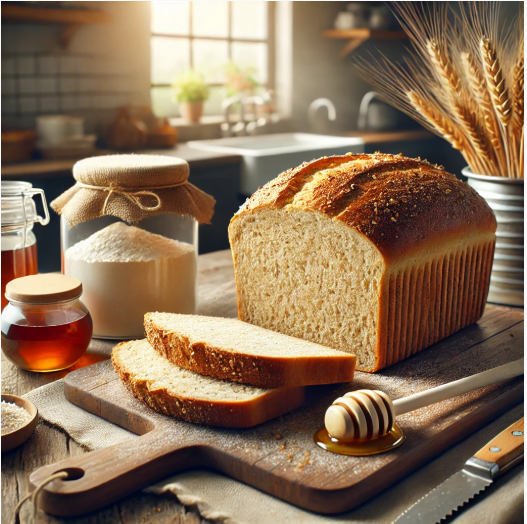Whole wheat bread is a staple for many people who want to enjoy delicious, hearty bread with a nutritional boost. Unlike white bread, which is made from refined flour, whole wheat bread uses the entire wheat kernel—bran, germ, and endosperm—resulting in a loaf that’s richer in fiber, vitamins, minerals, and flavor.
In this article, you’ll learn how to make wholesome, flavorful whole wheat bread at home, step-by-step, along with tips to keep your loaves soft, airy, and delicious.
- Why Bake Whole Wheat Bread at Home?
Store-bought whole wheat bread often contains preservatives, added sugars, and fillers that reduce its health benefits. Making it at home means you control every ingredient, from flour quality to salt levels.
Benefits include:
- Higher fiber content for better digestion
- More complex, nutty flavor
- Longer-lasting satiety
- Fewer additives and processed ingredients
- The satisfaction of baking your own healthy food
- Choosing the Right Flour
Whole wheat flour can vary greatly. The key is to understand your options:
- 100% Whole Wheat Flour: Made from the entire grain. It creates a hearty, dense loaf with rich flavor.
- White Whole Wheat Flour: A lighter variety made from a different type of wheat (hard white wheat). It retains whole grain benefits but has a milder flavor and softer texture.
- Stone-Ground Whole Wheat Flour: Coarser and more textured, it retains more natural oils and nutrients.
Pro tip: For lighter loaves, try using a 50/50 blend of whole wheat and bread flour or all-purpose flour. This keeps the nutritional benefits while improving rise and softness.
- Dealing with Density: The Hydration Factor
Whole wheat flour absorbs more water than white flour due to its bran content, which can lead to dry or dense bread if hydration is too low.
Tips:
- Increase hydration slightly compared to white bread recipes.
- Let the flour absorb water through autolyse (let flour and water rest before kneading).
- Use a slightly stickier dough—it bakes up lighter than a dry one.
- Boosting Rise with Vital Wheat Gluten (Optional)
Vital wheat gluten is a protein extracted from wheat that helps improve elasticity and structure. Adding 1–2 tablespoons per loaf can give your whole wheat bread more oven spring and a better crumb.
This is especially useful if you’re baking 100% whole wheat loaves without mixing in bread flour.
- Sweeteners and Fats: For Flavor and Moisture
Whole wheat bread can sometimes taste a bit bitter due to the wheat germ and bran. A little sweetness balances the flavor and helps feed the yeast.
Try adding:
- 1 to 2 tablespoons of honey, molasses, or brown sugar
- A tablespoon or two of olive oil, butter, or coconut oil for softness
These ingredients improve texture and shelf life without compromising the bread’s healthiness.
- Kneading and Gluten Development
Whole wheat dough takes longer to knead due to bran’s sharp edges, which can cut through developing gluten strands.
Tips:
- Knead for about 10–12 minutes by hand or 7–8 minutes in a stand mixer.
- If the dough is tearing or not stretching, let it rest and try again.
- Use the windowpane test to check gluten strength.
- Fermentation and Proofing
Whole wheat doughs ferment more slowly than white doughs, but they also benefit from longer fermentation. Consider doing a bulk ferment at room temperature for 2 hours or even overnight in the fridge.
Proofing tips:
- Allow the dough to double in size.
- Don’t overproof—whole wheat dough can collapse if left too long.
- Shaping and Baking
Shape the dough into a tight, smooth loaf and place it in a greased or parchment-lined loaf pan. Let it rise a second time until it reaches just above the rim of the pan.
Baking tips:
- Bake at 375°F (190°C) for 35–40 minutes.
- The crust should be firm and golden brown.
- The internal temperature should reach 190°F to 200°F (88°C to 93°C).
If the top is browning too quickly, tent it with foil during the final 10–15 minutes of baking.
- Cool and Slice with Care
Let the loaf cool completely on a wire rack—about 1 to 2 hours—before slicing. Cutting too early can squash the crumb and trap steam inside, making it gummy.
Use a serrated bread knife to get even slices.
- Storing Whole Wheat Bread
Homemade whole wheat bread will stay fresh for 3–4 days at room temperature.
Storage tips:
- Keep in a bread box or paper bag for a crispy crust.
- For softness, store in a sealed plastic bag.
- Freeze extra slices in a zip-top bag for up to 3 months.
Thaw at room temperature or toast slices straight from the freezer.
Whole wheat bread brings together nutrition and flavor in a way that few other breads can. With the right techniques and a bit of planning, you’ll be baking loaves that nourish your body and taste incredible—day after day.
